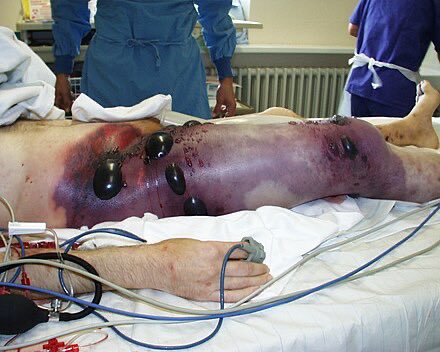Makindo Medical Notes"One small step for man, one large step for Makindo" |
|
|---|---|
| Download all this content in the Apps now Android App and Apple iPhone/Pad App | |
| MEDICAL DISCLAIMER: The contents are under continuing development and improvements and despite all efforts may contain errors of omission or fact. This is not to be used for the assessment, diagnosis, or management of patients. It should not be regarded as medical advice by healthcare workers or laypeople. It is for educational purposes only. Please adhere to your local protocols. Use the BNF for drug information. If you are unwell please seek urgent healthcare advice. If you do not accept this then please do not use the website. Makindo Ltd. |
Gas Gangrene (Clostridial Myonecrosis)
-
| About | Anaesthetics and Critical Care | Anatomy | Biochemistry | Cardiology | Clinical Cases | CompSci | Crib | Dermatology | Differentials | Drugs | ENT | Electrocardiogram | Embryology | Emergency Medicine | Endocrinology | Ethics | Foundation Doctors | Gastroenterology | General Information | General Practice | Genetics | Geriatric Medicine | Guidelines | Haematology | Hepatology | Immunology | Infectious Diseases | Infographic | Investigations | Lists | Microbiology | Miscellaneous | Nephrology | Neuroanatomy | Neurology | Nutrition | OSCE | Obstetrics Gynaecology | Oncology | Ophthalmology | Oral Medicine and Dentistry | Paediatrics | Palliative | Pathology | Pharmacology | Physiology | Procedures | Psychiatry | Radiology | Respiratory | Resuscitation | Rheumatology | Statistics and Research | Stroke | Surgery | Toxicology | Trauma and Orthopaedics | Twitter | Urology
Related Subjects: |Cellulitis |Pyoderma gangrenosum |Pemphigus Vulgaris |Toxic Epidermal Necrolysis |Stevens-Johnson Syndrome |Necrotising fasciitis |Gas Gangrene (Clostridium perfringens) |Purpura Fulminans |Severe burns |Anatomy of Skin
Gas gangrene (clostridial myonecrosis) is a rapidly progressive, life-threatening infection of muscle caused most commonly by Clostridium perfringens. It is a true surgical emergency with mortality approaching 100% if untreated. Early recognition, urgent surgical debridement, and broad-spectrum antibiotics are essential.
About
- Caused by Clostridium species (esp. C. perfringens, C. septicum, C. novyi).
- Organisms thrive in anaerobic, ischaemic tissue and produce potent toxins.
- Alpha toxin causes membrane destruction → necrosis, hemolysis, and systemic shock.
- Gas formation occurs from anaerobic metabolism in infected muscle.

Risk Factors
- Major trauma, compound fractures, crush injuries.
- Contaminated surgical wounds (GI, biliary, obstetric procedures).
- Underlying diabetes mellitus or peripheral vascular disease.
- IV drug use with contaminated injections.
- Colorectal cancer (spontaneous C. septicum gangrene).
Clinical Features
- Severe pain out of proportion to clinical findings (early red flag 🚩).
- Rapidly spreading swelling, tense bronzed skin, bullae, and dusky discoloration.
- Crepitus (gas in tissues, palpable crackling).
- Systemic toxicity: fever, tachycardia, hypotension, septic shock.
- Untreated → multi-organ failure within hours.
Investigations
- Bloods: ↑ WCC, ↑ CK (muscle necrosis), ↑ Creatinine, ↑ CRP. Coagulopathy (DIC) may develop.
- Imaging: CT/MRI shows gas in muscle compartments, fascial thickening. Imaging must not delay surgery.
- Microbiology: Gram stain → large gram-positive rods, paucity of neutrophils. Confirm with culture.
Complications
- Septic shock with multi-organ failure.
- Disseminated intravascular coagulation (DIC).
- Acute kidney injury (secondary to sepsis/rhabdomyolysis).
- Amputation of affected limb in extensive disease.
Management
- 🚨 Immediate surgical debridement (life-saving; multiple procedures may be needed).
- 💊 Antibiotics:
- First-line: Benzylpenicillin 1.2g IV qds + Metronidazole 500mg IV tds.
- If penicillin allergic: Clindamycin 600mg IV qds (also suppresses toxin production).
- 🌬️ Hyperbaric oxygen therapy (HBOT) may be considered but evidence is mixed.
- 💉 Supportive care: aggressive IV fluids, vasopressors if septic shock, ICU support.
- ✂️ Amputation may be necessary if debridement cannot control infection.
🚨 Clinical Vignette (Case)
A 62-year-old man with poorly controlled type 2 diabetes presents to the Emergency Department with severe pain in his left thigh after a minor laceration two days earlier. He appears acutely unwell: temperature 39.2 °C, HR 128, BP 85/60. His thigh is swollen, tense, and dusky-coloured. On palpation there is crepitus. The patient is confused and drowsy.
- Bloods: WCC 22 × 10⁹/L, CK 14,000, CRP 420, Creatinine 210.
- Imaging: CT scan shows gas tracking along fascial planes.
⚠️ This is classic for Gas gangrene (clostridial myonecrosis).
🩺 OSCE Station: Emergency Management of Gas Gangrene
Station Stem: "You are the surgical FY2 on call. A patient has been admitted with suspected gas gangrene. The examiner will play the role of your consultant. Please explain your initial management plan."
🔑 Key Domains (Marking Points)
- Recognition: Severe necrotising infection with systemic shock. Mention surgical emergency.
- Immediate Actions:
- Call senior surgical team urgently.
- Contact microbiology for antibiotic guidance.
- Escalate for ICU support (sepsis management, inotropes if needed).
- Antibiotics:
- Benzylpenicillin 1.2g IV qds + Metronidazole 500mg IV tds.
- If penicillin allergy → Clindamycin 600mg IV qds.
- Definitive Management:
- 🚨 Immediate surgical debridement (do not delay for imaging).
- Multiple debridements may be required.
- Amputation if uncontrolled spread.
- Supportive Measures:
- Aggressive IV fluids + vasopressors if septic shock.
- Analgesia and oxygen.
- Consider hyperbaric oxygen (discuss with microbiology).
💡 Examiner Tips (to teach students)
- Always use the phrase "surgical emergency".
- State you would start antibiotics immediately but not delay theatre.
- Remember sepsis 6 (O₂, blood cultures, IV antibiotics, fluids, lactate, urine output).
- Highlight the need for senior help — this shows safe practice.